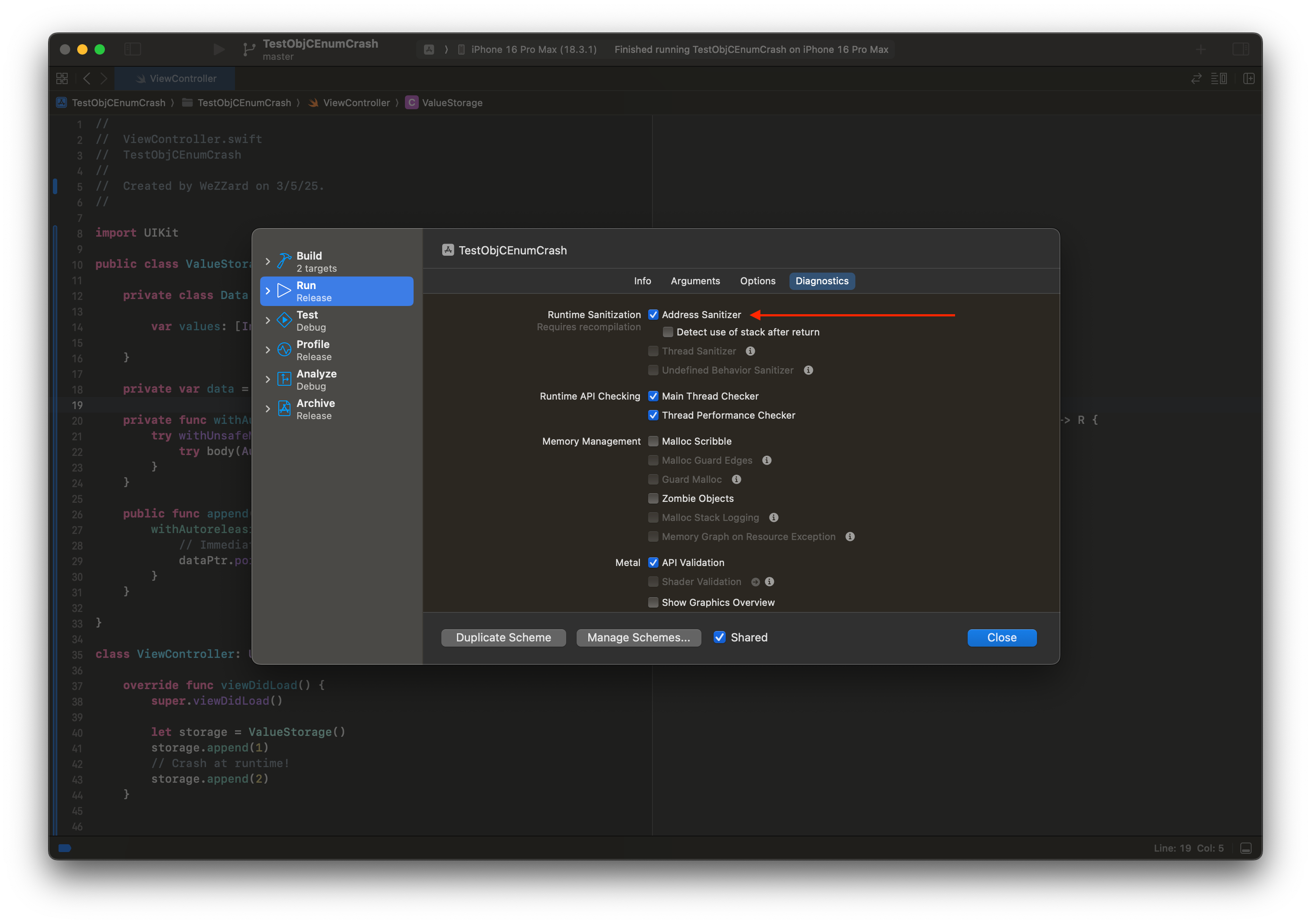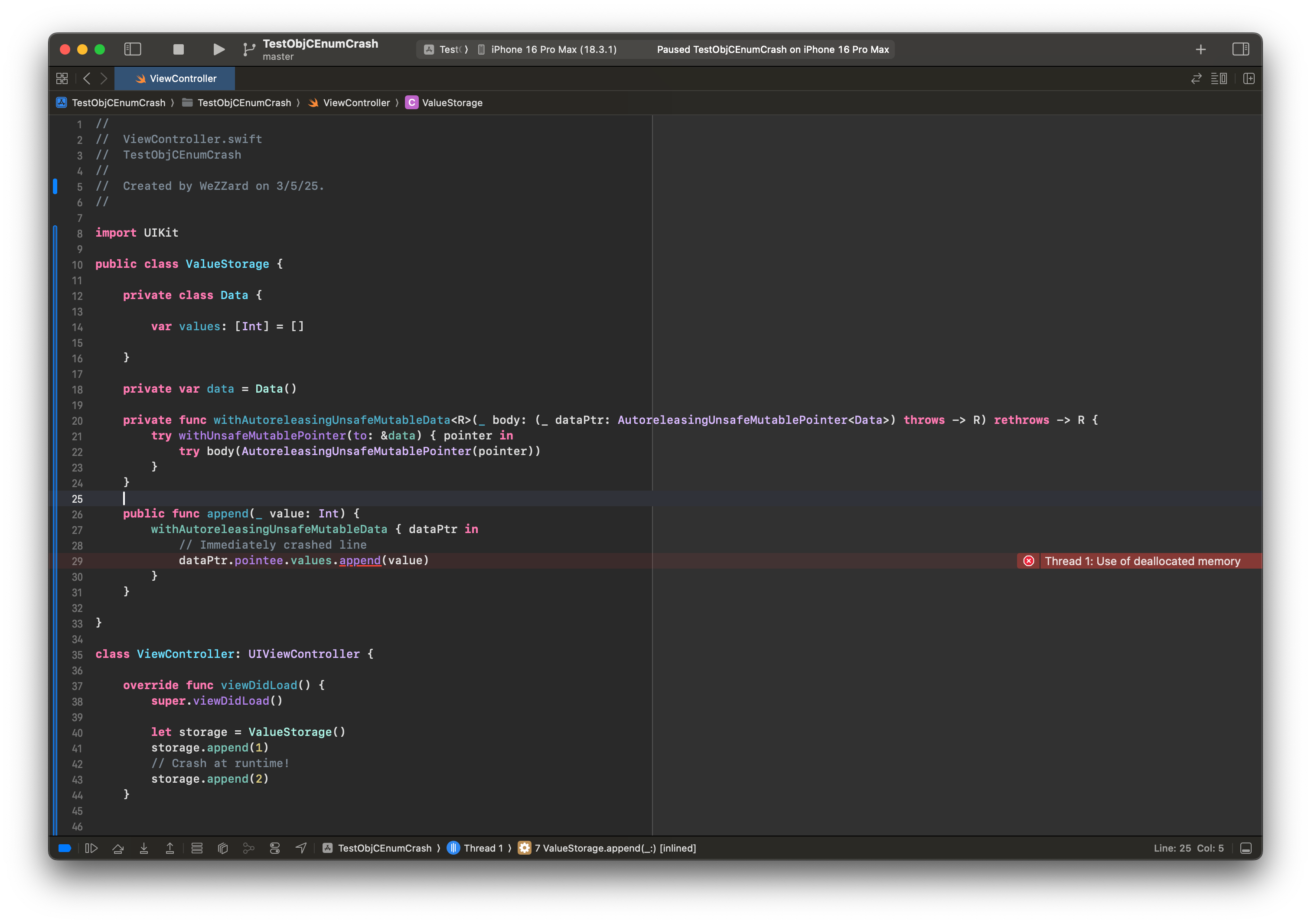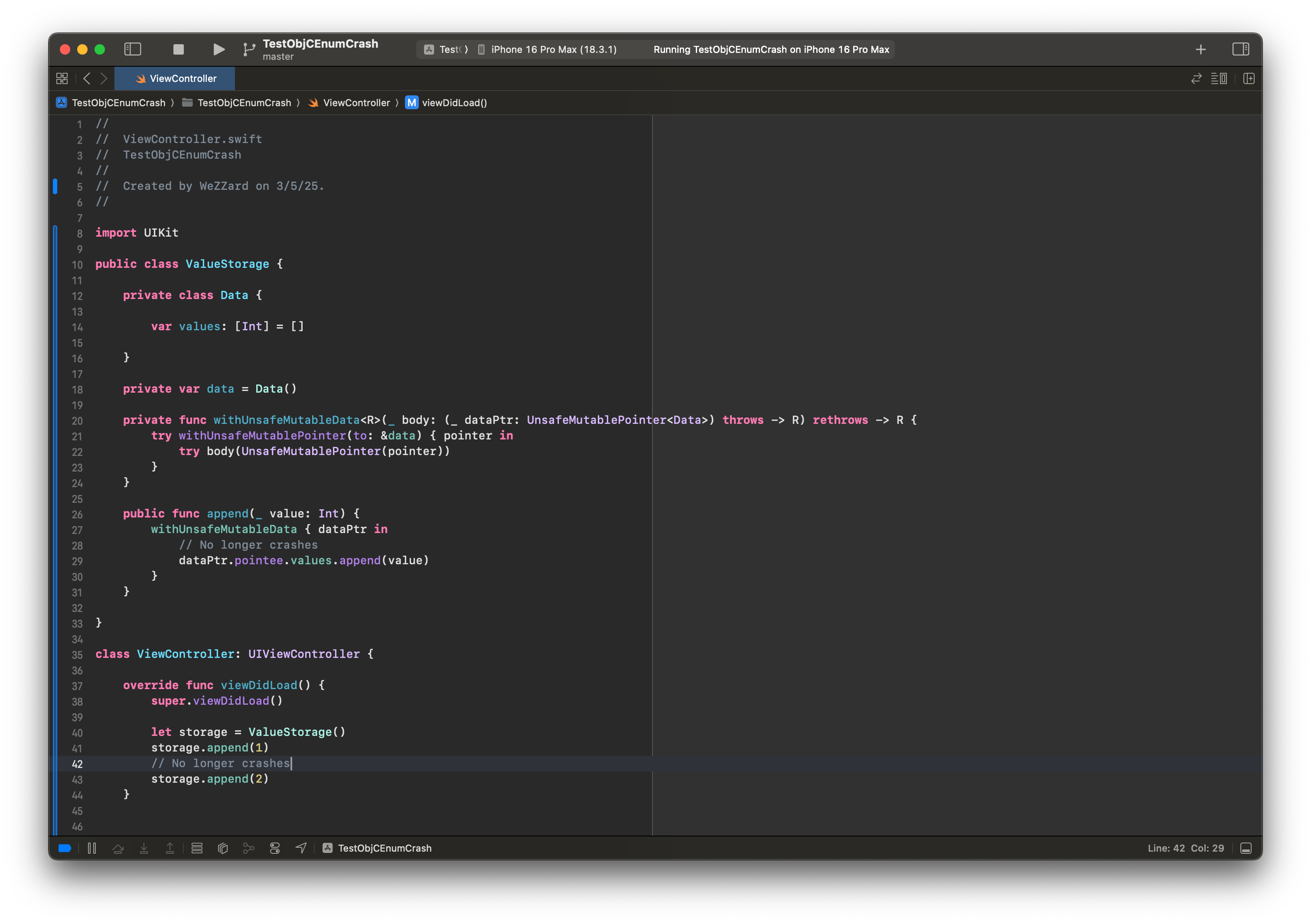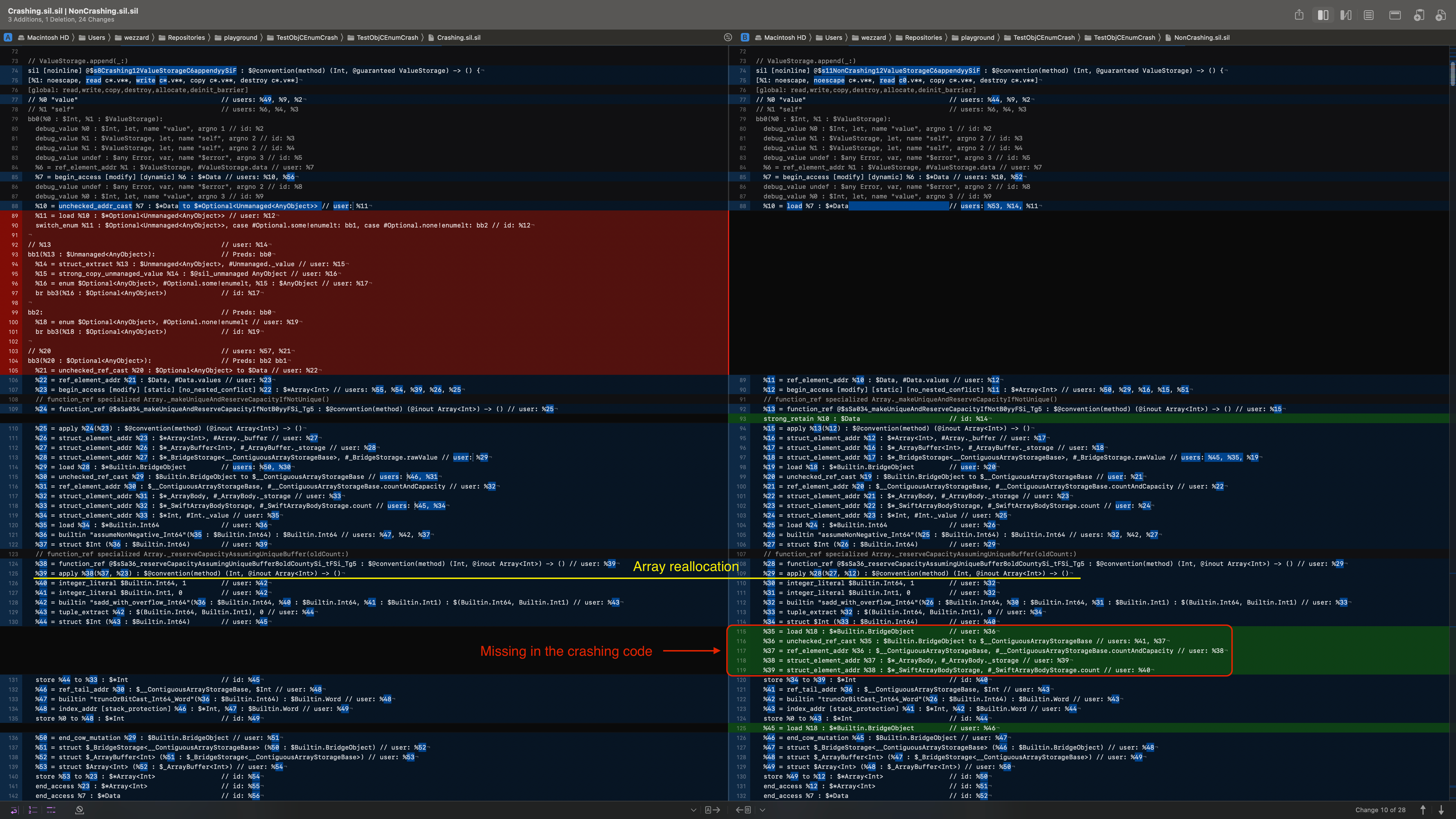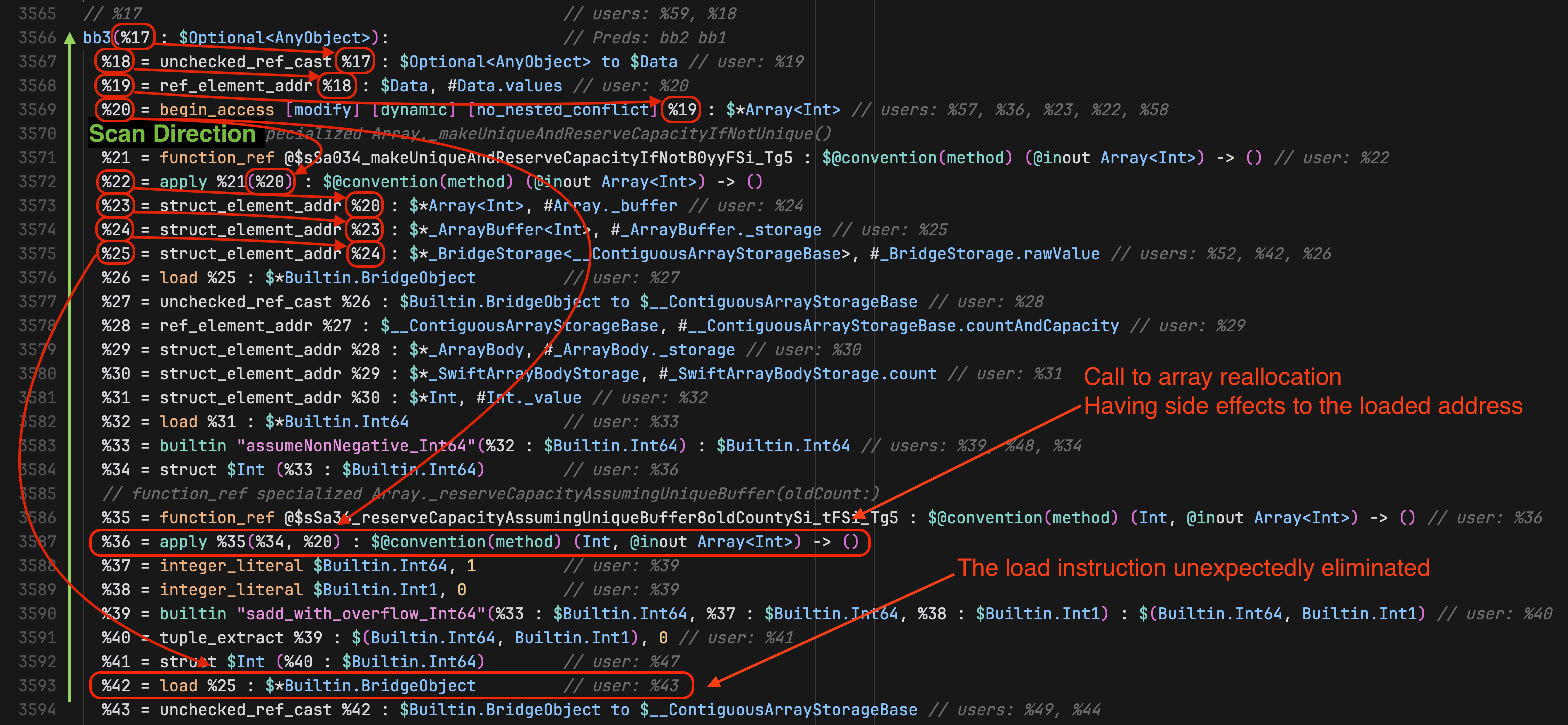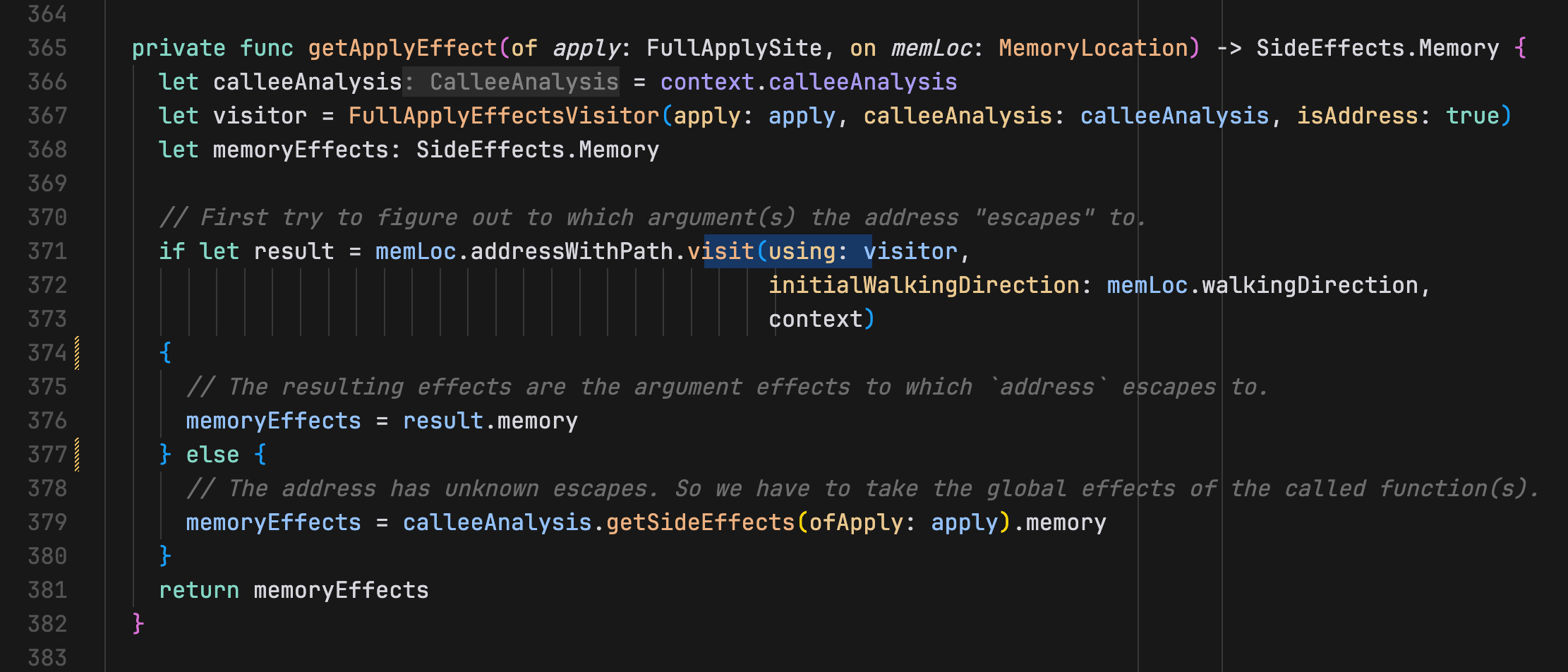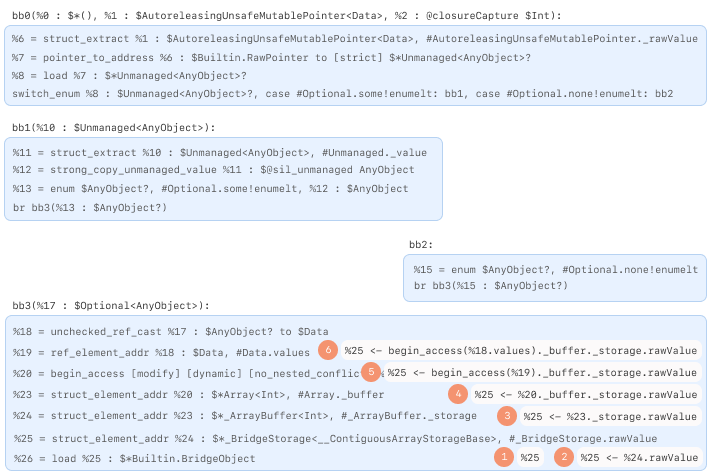When the Swift Compiler Deleted Code in Stdlib - A Note of Fixing the Eliminate Redundant Load Pass in Swift 6
Latest updated: Apple has accepted the fix for this issue. The final solution was adjusted following a review by the relevant code owner.
Right before the Chinese New Year vacation of the Year of the Snake, a
colleague showed me a mysterious crash caused by a use-after-free error.
Recently, I found time to investigate this issue and discovered that the
crash resulted from a miscompilation by the Swift compiler. The minimal
reproducible code appears below and must be compiled with the -Osize
optimization level. We can detect the use-after-free by enabling the
address sanitizer during compilation.
swift
Interestingly, replacing AutoreleasingUnsafeMutablePointer with
UnsafeMutablePointer eliminates the issue.
Investigating the Primary Scene of the Crash
After disassembling the problematic program, we can find that the Array
appending function was inlined in the ValueStorage.append function. The
key issue is that the program failed to re-acquire the Array's buffer
object after reallocation. This causes the address computed with register
r12 to point to the old buffer if reallocation occurred. The
disassembled code can be simplified as:
asm
Here is the complete disassembled code of ValueStorage.append:
Examining the Swift standard library reveals that the implementation
actually updates elements count and inserts new elements by accessing the
property _buffer on self, not an existing old buffer variable. The
Swift compiler incorrectly eliminated the re-acquisition of the _buffer
object in the target code.
swift
Why the Swift Compiler Deleted the Code
By examining the intermediate compilation products, we can find the
initial miscompilation in the "optimized SIL" output, which can be
obtained by adding the -emit-sil argument when invoking swiftc.
Comparing the optimized SIL of programs using AutoreleasingUnsafeMutablePointer
(left side) and UnsafeMutablePointer (right side) revealed that with
AutoreleasingUnsafeMutablePointer, a critical load of the array
storage was missing.
To identify which compiler pass removed this load, we can use the
-Xllvm argument to enable debug prints in the compiler. Specifically,
we can use --sil-print-function to make the compiler print the SIL of the
specified function whenever a pass modified its contents:
shell
The key logs from this analysis can be summarized as:
sil
From these logs, we can clearly see that the "redundant load elimination"
(RLE) pass deleted the following load instruction:
sil
Reasoning the Fix Solution
To develop a fix, we first needed to understand RLE. This pass optimizes code by eliminating redundant "get and set" operations for both virtual and real registers. Consider this example with virtual registers:
sil
An optimized equivalent would simply return %1 immediately, as %2 is
just an intermediate result. This is a case RLE should handle correctly.
Let's call this case 1.
sil
However, consider this more complex case:
sil
Here, elimination depends on whether Foo modifies the contents of %x.
If it does, we cannot directly return %1 because %3 = load %x loads
the updated contents. Let's call this case 2.
Now let’s examine how the Swift compiler implements redundant load
elimination. The main entry point resides in RedundantLoadElimination.swift:
swift
Follow the code from this entry point, we can find that the algorithm differs from classic RLE approaches:
- It iterates backward through instructions in each reverse-order basic block to find all
loadinstructions - For each
load, it examines prior instructions to find:- Available
storeinstructions for optimization (like the first case) - Available
loadinstructions for optimization (like the second case) when no functions with side effects to the address were called between loads
- A complexity budget limits instruction scanning for each load
Comparing the detailed behaviors of RLE with AutoreleasingUnsafeMutablePointer
and UnsafeMutablePointer, we can get the following log:
text
text
This reveals that:
- With
AutoreleasingUnsafeMutablePointer, RLE considered the array reallocation function "transparent" to the address of theloadinstruction's operand, enabling elimination - With
UnsafeMutablePointer, RLE correctly recognized that the function overwrites the address, preventing elimination
For case 2 scenarios, the Swift 6 algorithm checks all prior instructions
of the load to determine side effects of function calls between the
source of the load's operand and the load instruction itself.
The key insight is that the Swift compiler only evaluates function side
effects when the ultimate source of the load's operand has an unknown
escaping result. By setting breakpoints in the following function located
in AliasAnalysis.swift, I found the critical difference between the two
pointer types:
- With
AutoreleasingUnsafeMutablePointer, the compiler checks if the definition source of theloadinstruction's operand is escaping. When determined not to be escaping, the compiler incorrectly assumes the function has no side effects (line 376). - With
UnsafeMutablePointer, the compiler retrieves the global side-effects of the array reallocation function (likely from the@_effectsattribute. Only functions markedreadOnlyorreadNoneare considered side effect-free.) (line 381).
Further investigation led to the visit function at line 371, which
performs escape analysis on the load instruction's operand. The
following diagram illustrates this process:
This is the escape analysis process:
- Walks up the use-def chain to analyze escaping behavior
- Constructs a path representing how to derive the
loadinstruction's operand from its definition point in each step
The complexity arises with AutoreleasingUnsafeMutablePointer's pointee
getter implementation, which presents a non-trivial case for this escaping
analysis:
swift
The implementation details reveal that AutoreleasingUnsafeMutablePointer
must cast references from Optional<Unmanaged<AnyObject>> to the
Pointee type to maintain +0 reference counting. This casting is
performed through the _unsafeReferenceCast function:
swift
The compiler translates this to the Builtin.castReference function,
ultimately represented as an unchecked_ref_cast instruction in SIL:
sil
The problem arises because AutoreleasingUnsafeMutablePointer introduces
cases where $SourceSILType or $DesintationSILType may be Optional
types:
sil
This instruction can cast between Optional and non-Optional types,
effectively wrapping or unwrapping values. Since escape analysis walks the
use-def chain with a path that must strictly reflect how to derive the
load operand from its definition point, these implicit Optional
conversions create path mismatches, as illustrated:
This hypothesis is confirmed by examining the walkUpDefault function in
WalkUtils.swift, which handles various instruction types during the
walk-up but lacks proper handling for Optional conversions in
unchecked_ref_cast:
swift
Fix Solution
The solution is to account for Optional and non-Optional casting in
the use-def chain walk-up:
swift
The diagram below illustrates how this fix accommodates Optional and
non-Optional type conversions during escape analysis. When the escape
analysis process encounters an unchecked_ref_cast between Optional and
non-Optional types, the fix ensures proper path transformations by
adjusting the path to account for enum case differences.
A similar change is needed in the walkDownDefault function for def-use
chain analysis:
swift
After implementing this fix, compiling the AutoreleasingUnsafeMutablePointer
code produces logs showing that RLE correctly recognizes potential side
effects:
text
The optimized SIL now retains the critical load instruction after the
array reallocation:
sil
Tips for Debugging the Swift Compiler
Getting the Intermediate Products of the Swift Compiler
To examine the Swift compiler's intermediate representations at each compilation stage:
shell
Leveraging LLVM Pass-Through Arguments
LLVM provides numerous pass-through arguments that can be used with Swift:
shell
Building the Swift Compiler
What to notice is that, in this post, we are debugging the detailed
behaviors of the compiler, but the Swift programming language is bundled
with the standard library. Since the issue is coupled with the inlining
of the function Array.append, we shall build a debug version of the
compiler and a release version of the standard library to ensure the
inlining cost of Array.append as low as possible. This could be done
with the following command:
shell
Syntax Highlights for SIL and LLVM IR
You could search "WeZZard" in the extension market of VS Code (or Cursor) to get the syntax highlights for SIL in relevant IDE.
You could find the "LLVM" extension by Ingvar Stepanyan in the extension market of VS Code (or Cursor) to get the syntax highlights for LLVM IR in relevant IDE.
